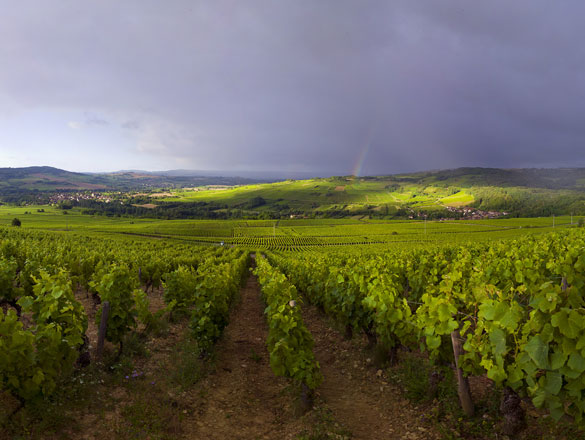

The vineyards of Bourgogne produce some great wines with a historical and international reputation. However, the region is not simply limited to its iconic appellations. In addition to its Village Premier Cru and Grand Cru AOCs, it also produces a range of wonderful Régionale and Village appellations to explore.
You will also find a full list of the Bourgogne’s Climats and lieux-dits on this page.
Check out the complete list of the 84 Bourgogne appellations.
However, your exploration has only just begun. Bourgogne wines have never before offered such high quality. Besides our range of internationally celebrated wines, try some of our lesser-known appellations where there are lots of surprises in store.
And for a fun way to find out more about the wines on offer, try out our “Which Bourgogne wine is right for me?” quiz, or check out Bourgogne Maps to take an interactive tour of the region.
Village appellation
VIGNOBLE DE LA CÔTE DE BEAUNE
31 juillet 1937
Almost entirely reds - Pinot Noir.
Whites - Chardonnay.
Area under production*:
1 hectare (ha) = 10,000 m2 = 24 ouvrées.
Reds: 180.77 ha (including 80.04 ha Premier Cru).
Whites: 19.11 ha (including 5.82 ha Premier Cru).
Average annual yield**:
1 hectolitre (hl) = 100 litres = 133 bottles.
Reds: 7,527 hl (including 3,328 hl Premier Cru).
Whites: 776 hl (including 229 hl Premier Cru).
*In 2022 **5-year average, 2017-2021
Appellation Village of the Côte de Beaune region (Saône-et-Loire).
The appellation MARANGES includes 7 Premiers Crus Climats.
Red wines grown within the defined area of this appellation may also claim the appellation CÔTE DE BEAUNE-VILLAGES.
Producing communes: Cheilly-lès-Maranges, Dezize-lès-Maranges, Sampigny-lès-Maranges.
Although lying in the département of Saône-et-Loire, this appellation forms an integral part of the Côte de Beaune.
The appellation MARANGES and MARANGES PREMIER CRU may be followed by the name of their Climat of origin.

Red: this wine boasts a brilliant colour - raspberry red, or sometimes darker and tending towards purple. Its fruit-laden bouquet is of blackcurrant buds, and spiced or preserved red fruits. The mouth, fresh, and tinged with liquorice, lays down a meaty foundation for peppery flavours. These wines have just enough acidity to ensure 3 or 4 years’ laying-down (more in the best years). Tannins are smooth, warm and melting, and vinosity is intense.
White: this wine is fine gold in colour, and is redolent of white flower scents (hawthorn, acacia, honeysuckle). With age, notes of gunflint or honey give depth to its personality. This wine is smooth and subtle, not forceful but refined in its details. Both reds and whites have won admirers among winelovers, especially since the Saint-Vincent Tournante of 1997.

Red: warm and fluid, its tannic structure is notably delicate and subtle. Its natural partners, therefore, are poultry and red meats which won’t clash with its tannins, especially in spicy exotic dishes to which its peppery vinosity forms a lively counterpart. The same goes for spring-rolls, grilled spare-ribs and barbecued pork, all of which require a wine that is exploding with fruit and spices.
Serving temperature: 14 to 16°C.
White: the smoothness and subtlety of its floral nuances naturally incline it towards cold main dishes with a vegetable base, antipasto, and fish terrines. But noble fish, salt or feshwater, simply fried will also welcome its fluidity, subtlety, and its floral refinement. Its natural vivacity also sits well with hard cheeses which have a slightly acid bite such as Cantal or Gouda.
Serving temperature: 12 to 13°C.

The Maranges area, which grows mainly Pinot Noir plus some Chardonnay, forms a link between the Côte-d’Or and the Saône-et-Loire. Its vineyards are interlocked with those of neighbouring Santenay, with which it shares some well-thought-of Premiers Crus. Maranges was granted its own AOC Village in 1988 covering the three villages of Cheilly-lès-Maranges, Dezize-lès-Maranges and Sampigny-lès-Maranges. The surrounding countryside has a character of its own - gentle and warm-hearted - which has been lovingly described by the Burgundian writer Henri Vincenot. The charmingly old-fashioned homes of the winemakers provide perfect subjects for a painter’s brush.

Though the hill-slopes are differently oriented to those of the Côte de Beaune, their nature and origins are geologically the same, making up a varied patchwork of hills and valleys. The vineyards mostly have a South/Southwesterly exposure and lie at altitudes of 240-400 metres. Cheilly, in the valley of the Cozanne, has rather light pebbly soils. Sampigny and Dezize share the Climats which lie to the South of Santenay on brown limestone soils and limey marls.
